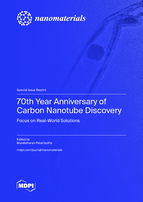70th Year Anniversary of Carbon Nanotube Discovery—Focus on Real World Solutions
A special issue of Nanomaterials (ISSN 2079-4991). This special issue belongs to the section "2D and Carbon Nanomaterials".
Deadline for manuscript submissions: closed (31 March 2023) | Viewed by 36765
Special Issue Editor
Interests: nanomaterials & nanotechnology; nanoscience for renewable energy; synthesis and applications of nanomaterials; nanoparticle- and/or nanofiber-based materials
Special Issues, Collections and Topics in MDPI journals
Special Issue Information
Dear Colleagues,
70 years ago in 1952, Russian scientists LV Radushkevich and VM Lukyanovich published clear images showing multiwalled carbon nanotubes (MWCNTs) having 50 nm diameter [1]. Their paper was in Russian, published in then Zhurnal Fizicheskoi Khimii (now Russian Journal of Physical Chemistry A), at the height of the Cold War. Radushkevich and Lukyanovich should be credited for the discovery that carbon filaments could be hollow and have a nanometer-size diameter, that is to say for the discovery of CNTs [2].
Now, it has been 30 years since Dr. Sumio Iijima of NEC Corporation in Japan observed single-walled carbon nanotubes (SWCNTs) and enabled popularization of MWCNTs by publishing his work in Nature in 1991. Thousands of papers published every year on CNT and linked areas relate to Dr. Sumio Iijima’s earlier work. He was awarded the Benjamin Franklin Medal in Physics in 2002, “for the discovery and elucidation of the atomic structure and helical character of multi-wall and single-wall carbon nanotubes, which have had an enormous impact on the rapidly growing condensed matter and materials science field of nanoscale science and electronics.”
CNTs are recognized for ultrahigh strength and deformability, high thermal conductivity, ballistic electrical conductivity, selected biocompatibility, unusual optical properties, and high surface area. Graphene and nanohorns are other well-known nanoscale forms of carbon, but CNTs remain distinguished by virtue of their one-dimensional or 1D structure, which enables directional tailoring of exceptionally favorable characteristics (enabling desired anisotropic properties) when required in application.
Current applications of CNT include:
(1) Durable battery electrodes;
(2) Optical/thermal nanodevices;
(3) Nanoscale reinforcement for strong and conductive hybrid nanocomposites;
(4) Ultrahigh performance CPUs for quantum computing;
(5) Anti-fouling eco-friendly coatings;
(6) High-efficiency recoverable and reusable catalysts and adsorbents;
(7) Nerve repair.
For real world sustainability, these applications are a subset of:
(A) Energy harvesting (1)/conversion (2)
(B) Ultra-strong multifunctional components (3)
(C) High performance and secure computing and data processing (4)
(D) Cost-saving green coatings (5)
(E) Systematic material recovery and reuse (6)
(F) Tissue regeneration (7)
Contributions are solicited in but not limited to the above applications, for this Special Issue commemorating 70 years of CNT research and application toward sustainability.
[1] Radushkevich, L.V.; Lukyanovich, V.M. O strukture ugleroda obrazujucegosja pri termiceskom razlozenii okisi ugleroda na zeleznom kontakte. Zhurnal Fizicheskoi Khimii 1952, 26, 88-95. (Translated into Radushkevich, L.V.; Lukyanovich, V.M. About the structure of carbon formed by thermal decomposition of carbon monoxide on iron substrate. Russian Journal of Physical Chemistry A 1952, 26, 88-95.)
[2] Monthioux, M.; Kuznetsov, V.L.; Guest editorial: Who should be given the credit for the discovery of carbon nanotubes? Carbon 2006, 44, 1621-1623.
Dr. Muralidharan Paramsothy
Guest Editor
Manuscript Submission Information
Manuscripts should be submitted online at www.mdpi.com by registering and logging in to this website. Once you are registered, click here to go to the submission form. Manuscripts can be submitted until the deadline. All submissions that pass pre-check are peer-reviewed. Accepted papers will be published continuously in the journal (as soon as accepted) and will be listed together on the special issue website. Research articles, review articles as well as short communications are invited. For planned papers, a title and short abstract (about 100 words) can be sent to the Editorial Office for announcement on this website.
Submitted manuscripts should not have been published previously, nor be under consideration for publication elsewhere (except conference proceedings papers). All manuscripts are thoroughly refereed through a single-blind peer-review process. A guide for authors and other relevant information for submission of manuscripts is available on the Instructions for Authors page. Nanomaterials is an international peer-reviewed open access semimonthly journal published by MDPI.
Please visit the Instructions for Authors page before submitting a manuscript. The Article Processing Charge (APC) for publication in this open access journal is 2900 CHF (Swiss Francs). Submitted papers should be well formatted and use good English. Authors may use MDPI's English editing service prior to publication or during author revisions.
Keywords
- nanotube
- nanostructure
- nanodevice
- nanocomposite
- chemical
- physical
- biological
- thermal
- optical
- electrical
- quantum
- catalyst
- energy
- computing
- multifunctional
- green
- nerve
- sustainable







